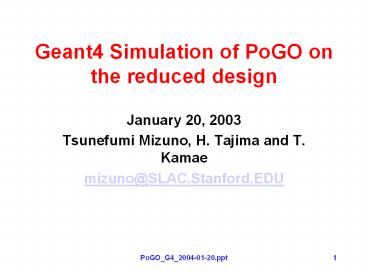Geant4 Simulation of PoGO on the reduced design PowerPoint PPT Presentation
1 / 6
Title: Geant4 Simulation of PoGO on the reduced design
1
Geant4 Simulation of PoGO on the reduced design
- January 20, 2003
- Tsunefumi Mizuno, H. Tajima and T. Kamae
- mizuno_at_SLAC.Stanford.EDU
2
Simulated Geometry
- Thickness of fast scint. 2.63cm
- (D 2.23cm)
- W (thickness of slow scint.) 0.2cm
- L1 (slow scint. length) 60cm
- L2 (fast scint. length) 20cm
- Thickness of W collimator 0.0025cm
- Thickness of btm BGO 2.68cm
- Length of btm BGO 3cm
- (not tapered in simulator for simplicity)
- Gap between BGOs 0.5cm
- (including BaSo4 eflector)
- Thickness of side Anti BGO 3cm
- Length of side Anti BGO 60cm
- of units 397 (geometrical area of fast scint.
not covered by slow scint. 1709cm2) or 217
(934.4 cm2)
Simulation of realistic geometry
3
Simulation Condition
- The same spectrum as that used in Hiros EGS4
simulation - E-2.1 spectrum with 100mCrab intensity, 20-200keV
(300.8 c/s/m2) - 6h exposure, attenuation by air of 3g/cm2
- Use Geant4 ver5.1. Possible minor bug of
polarization vector after scattering was fixed by
user (found and fixed by Y. Fukazawa _at_ Hiroshima
Univ.). - Assumed detector response
- 0.5 photo-electron/keV
- fluctuated by poission distribution and smeared
by gaussian of sigma0.5 keV - minimum hit threshold is 3 keV for both fast and
veto scintillators. - Event selection
- 2 or 3 hits in fast scintillators
- The largest energy deposit is considered to be
photo absorption and the second largest to be
compton scattering.
4
EGS4 results (for reference)
EGS4 MC prediction
polarization profiles of three models
Definitions of P1/P2/IP
5
G4 results for 397 units
- Fit the azimuth angle distribution with
p0(1p1cos(2(phi-p2)pi))
Crab Pulsar PolarizationP1
Crab Pulsar PolarizationP2
p20.273-0.035 (polar cap model) p21.62-0.07
(caustic model) p2-0.33-0.06 (outer cap model)
Polar Cap Model Caustic Model Outer Cap Model
MF3.14-0.46
- Modulation can be detected by 7 sigma or more
- We can distinguish models by 10 sigma or more
(difference of the phase)
We confirmed the EGS4 results with G4 simulation.
6
G4 results for 217 units
- Fit the azimuth angle distribution with
p0(1p1cos(2(phi-p2)pi))
Crab Pulsar PolarizationP1
Crab Pulsar PolarizationP2
p20.342-0.045 (polar cap model) p21.54-0.10
(caustic model) p2-0.22-0.10 (outer cap model)
Polar Cap Model Caustic Model Outer Cap Model
MF3.10-0.65
- Modulation can be detected by 5 sigma or more
- We can distinguish models by 6 sigma or more
(difference of the phase)
Even the PoGO of reduced design allows us to
distinguish three models in 6-hour observation.

